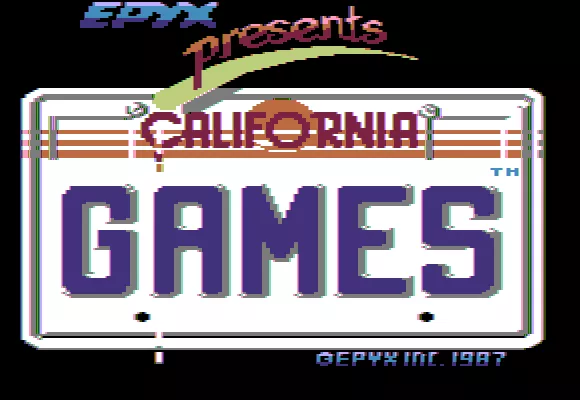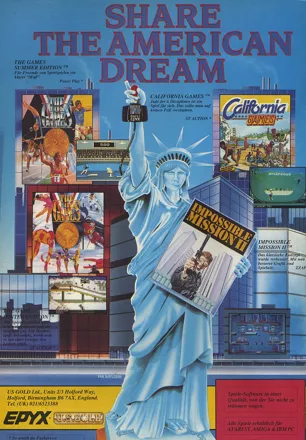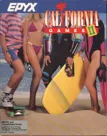California Games
-
 California Games
(2009 on
Windows, 2014 on
Android)
California Games
(2009 on
Windows, 2014 on
Android)
Description official descriptions
California Games was the original "Extreme Games" – what today's generation might call "X-Games in the sun". Players can select sponsors (absent in some versions) and compete in events such as skateboarding, footbag, surfing, roller skating, flying disc (frisbee) and BMX. The surfing event is ranked by judges, which give a score to help the players improve their routine.
The Atari versions (2600 and Lynx) of the game omit the flying disc and roller skating events, while the Genesis version omits only the flying disc event.
Groups +
Screenshots
Promos
Credits (Commodore 64 version)
12 People
| Game Design by | |
| Graphics by | |
| Music by | |
| Copyright for song "Louie, Louie" by |
|
Reviews
Critics
Average score: 74% (based on 56 ratings)
Players
Average score: 3.6 out of 5 (based on 161 ratings with 3 reviews)
This radical game is totally awesome dude!
The Good
Please forgive me for talking like Bill & Ted in my online summary, I just wanted to give an example of the language used in this game. If you didn't know by now, California Games is about extreme sports that became popular in the eighties.
- The whole eighties extreme sports theme is one of the reasons why this game is fun. It's visible in the gameplay, the cool graphics, the (official) brand names and, as mentioned, in the language. This one simply has style, just look at the cool title screen with the state of California license plate. You just got to love the game's presentation.
- The game has many nice touches and charming humor: Hitting the seagull with the footbag, the letters of the Hollywood sign falling down, the boy whistling at the girl while roller-skating, the appearance of the dolphin during surfing etc.
- Great graphics & animation (the surfing event was especially well done) and neta sound effects (always used at the right moments). The music was allright and fortunately it only played before the start of an event, not while you were competing so it didn't distract you (No, I'm not a big fan of PC speaker tunes).
- Of course Calgames wouldn't have become a classic if it didn't also had great gameplay. Oh boy, Calgames is easily the best of Epyx's Games-series. There are six events: Half-Pipe, Footbag, Roller-Skating, Surfing, Flying Disc and BMX.
- All the events are fun to play.
- All the events are different (unlike
Winter Games with biathlon & cross-country and, yuck, two figure-skating events). - All the events had controls you could actually master (unlike the high-jumping event in
Summer Games II or bull-riding inWorld Games ) - And best of all, none of the events relied on button-bashing (think speed-skating from Winter Games or Summer Games' rowing).
- This was a great game to play with the family or a friend. Up to 6 (or 8?) persons could compete in the tournament and everybody had his favorite events. Before the tournament you could pick your own sponsor and for every event there were some huge trophies you could win.
**The Bad**
- You couldn't do any cool tricks on the half-pipe (only turns).
- I always fell down the ramp at the end of the BMX course :->
**The Bottom Line**
One of the definite classics of the first decade of PC gaming. I can't imagine there's anybody out there who doesn't like playing California Games.
DOS · by Roedie (5239) · 2001
SMS California Games in Better than Genesis Version Shocker
The Good
California Games on the Master System was a gem. It was a game that was intended for multiplayer but was worth playing solo to sharpen your skills. What I like about Cal Games is the simple pick up and playability of it.
All the events on the game were very easy to control and as a result this meant that it was a very competitive game. In the SMS version there are 6 different events in which to partake: Half Pipe, Footbag, Surfing, Skating, BMX & Flying Disk (Frisbee). Each one was very different and very pleasing to play.
It had advantages over the Genesis/Mega Drive version in that it contained an extra event & was easier to control. The SMS version was more simplified and better off for it. It was no slower than its 16-Bit counterpart and looked very good.
Beating a pre-set high score gave you the chance to 'win' a prize. Golden surfboard, Bike or Footbag. Gaining one of these would make the respective events a lot more interesting as they would have better attributes. For example the Golden BMX could jump higher, allowing for a higher score to be attained.
That feature was really placed to enhance the solo mode. But the multiplayer didn't need them, as it was great fun with a few friends (as many as 9 could compete).
Altogether an accomplished title that still holds up today
The Bad
The surfing section could be a little boring, this was the only event that was better on the Genesis/Mega Drive version
The Bottom Line
If you are looking for a sports game that is a little different, this is it. Fun for one player or more.
SEGA Master System · by Liam Dowds (39) · 2003
It's GREAT to be playing CALIFORNIA GAMES!
The Good
Ahh! No matter on which platform I play California Games, when I START the
games I really can't help myself playing 2 or 3 hours at least. California Games
is one of my all-time favorites and has a very special place in my humble gaming
experience. It's so addictive, so perfect arcade gaming it's GREAT to be playing it!
All events in the game share the same soul of the 80s; being able to compete in
events such as BMX and footbag also increase the enjoyment (Yeah, I bet you remember
the BMX mania which was back in the days but I never heard "footbag" before until I
played California Games!) But of course everyone has their favorite events and for me
they were surfing and rollerskating which I played most, I enjoyed most. I really missed
the blonde girl in the "surf judge panel" who was always giving me my highest scores
and the boy who was whistling for me when I passed slowly in front of him while
rollerskating :) And what about skateboarding? I was so talented on it that "Hollywood"
in the hills had always dropped one of its letters with my earthquake effect! But
to be honest I wasn't so good at flying disk (Frisbee!). You should have seen one
of my spectacular jumps over the frisbee which was generally concluded dropping by,
to the left of the screen, while frisbee was on its way to the right of the screen!
The Bad
Its sequel was a huge disappointment, unfortunately :(
The Bottom Line
All in all, California Games is the best of Epyx. And I enjoyed almost
every minute of it! Surely a classic...
DOS · by Accatone (5191) · 2000
Trivia
1001 Video Games
California Games appears in the book 1001 Video Games You Must Play Before You Die by General Editor Tony Mott.
Atari 2600 version
The Atari 2600 version of California Games, released in the later years of Atari's dominance in the Home Video Game market, was one of a handful of games that used 16K of memory. The Atari 2600 had been designed to only run cartridges of 2K and 4K in size. Games that were written to exceed that 4K memory limitation required the "bank swapping" technique in order to access 8K, 12K, and even 16K game cartridges.
Memory was still expensive in the 1980's, yet the public wanted more and more advanced games, especially since it had been several years now since the release of the many popular 8-bit home computer systems that had been flooding the market and reducing in cost. And with the Nintendo Entertainment System having just been released, the Atari 2600 was beginning to look very dated. In order to satisfy the public’s craving for games requiring increasing amounts of memory, creating a bigger game for the Atari 2600 was the only way to do it.
In order to handle the expansiveness of their games, Epyx released all three of their Olympic-based games with multiple ROM chips equaling the necessary 16K. Using bank-swapping, the various ROM chips could be accessed and swapped as needed. And all of it was embedded within a standard-sized Atari 2600 Cartridge!
Gags
During the flying disc event, if you leave the controls alone for long enough, you will see an alien abducting your partner on the radar, along the top of the screen (see screenshots).
Graphics
California Games was one of the handful of games released that pushed CGA to its limits by using a timing/hardware trick to get more colors on the screen. It called this trick "MORE-color" mode (as opposed to the normal "4-color" mode), and it achieved 7 different colors on the same screen by switching from one color palette to another at a particular scanline. The switch was masked fairly well by:
- making sure that the graphics had a horizontal boundary somewhere on the screen that wouldn't look funny by a color switch, and
- switching from the red-green-yellow palette to a tweaked red-cyan-white palette and using the common red color to mask the switch.
You can see how much better these screens looked by going to the Screenshots section of the California Games entry and looking at the shots marked "CGA MORE-color". While not as good as EGA, they were definitely much, much better than what CGA could normally produce.
While this technique has been used in other games (like Jungle Hunt), none did it so well as in California Games.
This technique will only work on 4.77MHz machines, as the timing required to change the palette is very exacting. Also, there is no way to capture, with a program, these screenshots; they had to be captured normally, then changing the used colors where the split occurred. They are identical to what's displayed on the screen, however, down to the additional color split in the names at the bottom of the title screen. )
Lynx version
- While the rollerskating event was taken out of the Lynx version of the game, you can still see the rollerskating girl skate by during the high-score screen.
- While the Lynx version of the game only officially supports 2 players, you can ComLynx up to four if everyone turns on their Lynxes simultaneously. It may take a couple of tries, but it is possible. Gameplay is slightly slower in this mode whenever more than two players are onscreen at the same time.
- In the Lynx version, the wave in the surfing section moves from right to left. In all other versions of the game, the wave moves from left to right.
Manual
In the Lynx version's manual, it reads: "Score an extra 50 points for hitting the seagull in the beak with the foot bag (but only in this game -- be kind to the birdies in the other events)."
Music
The main theme song is a cover of Richard Berry's Louie Louie, later made famous by Kingsmen.
RAM
When you play California Games on a PC with enough RAM, you'll get a message like this:
You've got 167K RAM more than you need, Dude.
That's gnarly!
Awards
- Commodore Format
- February 1991 (Issue 5) - listed in the A to Z of Classic Games article (Great)
- March 1994 (Issue 42) Heaven – The Path to Righteousness: 20 Essential Games
- ZZAP! 64
- Newsfield Reader's Awards 1987 - Best Game (readers choice)
Information also contributed by Apogee IV, Thomas Perl, Trixter and SirOrlando
Analytics
Related Sites +
-
AtariMania (Epyx release, USA)
For Atari 2600: game entry database; downloadable release; game packaging; advertisement; manuals; magazine reviews; additional material. -
AtariMania (Epyx, Europe)
For Atari ST: game entry database; downloadable release; game packaging; advertisement; manuals; magazine reviews; additional material. -
AtariMania (Epyx, USA)
For Atari ST: game entry database; downloadable release; game packaging; advertisement; manuals; magazine reviews; additional material. -
AtariMania (Epyx, Worlwide)
For Atari 2600: game entry database; downloadable release; game packaging; advertisement; manuals; magazine reviews; additional material. -
AtariMania (HES release, Australia)
For Atari 2600: game entry database; downloadable release; game packaging; advertisement; manuals; magazine reviews; additional material. -
AtariMania (Kixx, UK)
For Atari ST: game entry database; downloadable release; game packaging; advertisement; manuals; magazine reviews; additional material. -
AtariMania (Salu, Worldwide)
For Atari 2600: game entry database; downloadable release; game packaging; advertisement; manuals; magazine reviews; additional material. -
CPC-Power (in French)
For Amstrad CPC: game database entry; game packaging; manual digitalizations; goodies; advertisement; magazine reviews; downloadable releases; additional material. -
CPCRrulez (in French)
For Amstrad CPC: game database entry; advertisement; game packaging; downloadable releases; additional material. -
Cambridge Centre for Computing History (Atari Lynx)
For Atari Lynx: exhibit reference CH40324; additional material. -
Cambridge Centre for Computing History (Commodore 64)
For Commodore 64: exhibit reference CH18325; additional material. -
Cambridge Centre for Computing History (Commodore 64)
For Commodore 64: exhibit reference CH35616; additional material. -
Cambridge Centre for Computing History (Sega Master System)
For Sega Master System: exhibit reference ID CH13239; additional material. -
Cambridge Centre for Computing History (Sega Mega Drive)
For Sega Mega Drive: exhibit reference CH39973; additional material. -
Cambridge Centre for Computing History (ZX Spectrum)
For ZX Spectrum: exhibit reference CH18601; additional material. -
Commodore 64 Boxed Sets
For C64: high quality game packaging digitalisations. Include box, manual, brochure, additional material. -
DOSBox, an x86 emulator with DOS
Statistics page of compatibility with original DOS version. -
Hall of Light
For Amiga: game database entry; digitalised manuals; game packaging; screenshots; additional material. -
IMDb, the Internet Movie Database
For combined platforms: game database entry. -
Kio's home
For ZX Spectrum: additional material including – photographed cassete inlay; snapshots; downloadable releases. -
Lemon 64
For C64: game entry database; advertisement; magazine reviews; music; documentation; cover art; additional material. -
Lemon Amiga
For Amiga: game database entry; magazine reviews; music; manual; additional material. -
MSX Generation
For MSX: game database entry; game packaging; manuals; additional material. -
Metacritic (C64: wii)
For C64, wii: reviews; ratings; critics; trailers; additional material. -
Metacritic (PSP)
For PSP: reviews; ratings; critics; trailers; additional material. -
NES Player - California Games
Tribute site with information about the game. -
Replacementdocs (Manual)
Documentation for Sega Master System. -
SMS Power!
For Sega Master System: releases info; credits; box text; additional material. -
Sega8bit, a Master System fan site
For SEGA Master System: artwork; releases; additional material. -
Wikipedia, the free encyclopedia
Encyclopaedic entry for combined platforms. -
World of Spectrum
For ZX Spectrum: downloadable releases; additional material including – cassete inlay, advertisement, instructions; remakes links; player reviews; magazine references; magazine adverts. -
ZX Spectrum Reviews
For ZX Spectrum: magazine game reviews in HTML.
Identifiers +
Contribute
Are you familiar with this game? Help document and preserve this entry in video game history! If your contribution is approved, you will earn points and be credited as a contributor.
Contributors to this Entry
Game added by Macintrash.
NES, Lynx added by POMAH. Commodore 64, SEGA Master System, Genesis, Atari 2600 added by PCGamer77. Antstream, Windows added by firefang9212. MSX added by Kohler 86. Amstrad CPC, ZX Spectrum, J2ME added by Kabushi. Wii added by gamewarrior. Apple II added by Terok Nor. Atari ST added by Servo. Apple IIgs added by Garcia. Amiga added by Rantanplan.
Additional contributors: Apogee IV, chirinea, Pseudo_Intellectual, Patrick Bregger, Jo ST, FatherJack, ZeTomes.
Game added June 28th, 2000. Last modified January 20th, 2024.

















